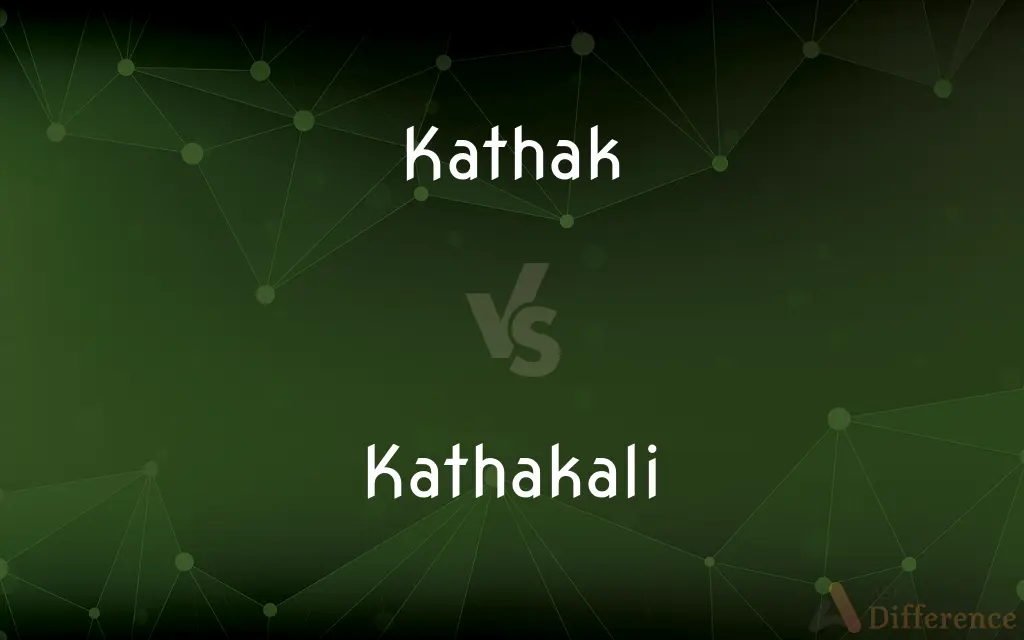Kathak vs. Kathakali — What's the Difference?
By Tayyaba Rehman & Fiza Rafique — Updated on April 17, 2024
Kathak is a North Indian classical dance form known for its intricate footwork and rapid spins, while Kathakali is a South Indian dance-drama noted for its elaborate makeup, costumes, and expressive gestures to tell stories from Hindu epics.

Difference Between Kathak and Kathakali
Table of Contents
ADVERTISEMENT
Key Differences
Kathak originated in the courts of North India, evolving into a sophisticated dance form known for its graceful movements and strong emphasis on rhythm and footwork. On the other hand, Kathakali emerged in Kerala, South India, and is characterized by its dramatic, almost theatrical presentation, where dancers use exaggerated facial expressions and body movements to convey stories.
Kathak dancers typically wear costumes that are elegant but less voluminous, allowing freedom of movement for complex footwork and spins. In contrast, Kathakali costumes are elaborate and heavy, featuring large head-dresses, layered clothing, and extensive face paints, which transform performers into mythological characters.
The music in Kathak is based on Hindustani classical, with instruments like the tabla and the sitar accompanying the dance. Kathakali, however, uses Carnatic music with traditional instruments such as the chenda, maddalam, and edakka, creating a resonant backdrop that enhances the dramatic effect.
Kathak performances can be both narrative and abstract, focusing on storytelling through dance as well as technical showcases of rhythm and footwork. Kathakali strictly adheres to storytelling, using a codified system of gestures (mudras) and facial expressions to narrate scenes from the Mahabharata, Ramayana, and other ancient scriptures.
Both dance forms include elements of mime, but Kathakali is particularly detailed in its use of hand gestures and facial expressions to communicate the story, making it more visually oriented than Kathak, which focuses more on dance and movement to convey emotion and narrative.
ADVERTISEMENT
Comparison Chart
Origin
North India
Kerala, South India
Costumes
Elegant and less voluminous
Heavy, elaborate with face makeup
Music
Hindustani classical
Carnatic music
Main Focus
Footwork, spins, and rhythm
Dramatic storytelling, expressions
Performance
Narrative and abstract
Strictly narrative
Instruments
Tabla, sitar
Chenda, maddalam, edakka
Compare with Definitions
Kathak
A classical dance form from North India known for its precise footwork.
The Kathak dancer impressed the audience with her rapid spins and complex rhythmic patterns.
Kathakali
Uses elaborate costumes and makeup to depict characters from Hindu epics.
His costume in the Kathakali play was colorful and detailed, representing a heroic figure from the Ramayana.
Kathak
Performed wearing light costumes that allow agility.
She wore a sparkling Anarkali suit, enhancing her swift movements during the Kathak recital.
Kathakali
Primarily focuses on conveying stories through expressive acting.
The Kathakali performance told a story of divine vengeance with powerful expressions and movements.
Kathak
Involves storytelling through dance movements and facial expressions.
The Kathak performance narrated a tale of love and valor through expressive dance and music.
Kathakali
Performed to the sound of traditional Kerala music.
The intense scenes in Kathakali were accentuated by the dramatic beats of the chenda.
Kathak
Often includes narrative elements but focuses on dance technique.
The Kathak recital combined lyrical storytelling with intricate technical demonstrations.
Kathakali
A South Indian dance-drama known for its vivid theatricality.
The Kathakali actor's makeup and gestures vividly brought the epic characters to life.
Kathak
Emphasizes technical skill and grace.
His Kathak routine showcased exceptional control and elegance in both slow and fast tempos.
Kathakali
Relies heavily on facial expressions and hand gestures for storytelling.
Every subtle facial twitch and detailed gesture in Kathakali communicates specific emotions and actions.
Kathak
Kathak is one of the eight major forms of Indian classical dance. The origin of Kathak is traditionally attributed to the traveling bards in the northern areas of Ancient India known as Kathakars or storytellers.
Kathakali
Kathakali (Malayalam: കഥകളി) is a major form of classical Indian dance. It is a "story play" genre of art, but one distinguished by the elaborately colorful make-up, costumes and face masks that the traditionally male actor-dancers wear.
Kathak
One of the eight classical dance forms of India.
Kathakali
A spectacular lyric dance drama of southern India performed with acrobatic energy and highly stylized pantomime.
Common Curiosities
What kind of stories do Kathak and Kathakali tell?
Kathak may tell various stories through dance or focus on abstract dancing, while Kathakali specifically tells traditional stories from Hindu epics.
What are the key musical differences between Kathak and Kathakali?
Kathak uses Hindustani classical music, while Kathakali features Carnatic music, each with distinctive instruments and styles.
What is the significance of facial expressions in Kathakali?
Facial expressions in Kathakali are highly codified and crucial for narrating the story, often requiring years of training to master.
What training is required to become a proficient dancer in Kathak and Kathakali?
Both dance forms require extensive training. Kathak dancers focus on mastering footwork, spins, and rhythmic skills, often starting with basic steps and gradually incorporating complex patterns and expressions. Kathakali training is rigorous, with an early start recommended; it involves learning elaborate gesture languages, facial expressions, and handling heavy costumes, in addition to physical and vocal training.
Can both Kathak and Kathakali include solo performances?
Yes, both can be performed solo or as part of a group, although Kathakali is more commonly performed in a group to depict various characters of a story.
Are there gender-specific roles in Kathak and Kathakali?
Traditionally, Kathakali was performed by men, including the female roles, but now it is performed by all genders. Kathak does not have gender-specific roles and is performed by individuals of any gender.
How do the costumes of Kathak and Kathakali differ?
Kathak costumes are elegant and facilitate movement, whereas Kathakali costumes are more voluminous and elaborate, aimed at transforming the performer visually into mythological characters.
How do the audiences differ for performances of Kathak versus Kathakali?
Kathak is popular across various audiences in India and internationally, appreciated in classical dance concerts, fusion performances, and formal competitions. Kathakali tends to attract audiences who are more deeply interested in traditional Indian epics and cultural stories, often performed at cultural festivals, temples, and special ceremonial events.
How accessible are these dance forms for new learners?
Both forms are accessible but require dedication to master, with Kathakali demanding particular skill in handling elaborate costumes and makeup, as well as learning the detailed gesture language.
How do costumes and makeup influence the performance of Kathakali?
In Kathakali, costumes and makeup are crucial as they help delineate character types (like gods, kings, demons, and animals), each defined by specific colors and designs. These elements significantly enhance the theatrical effect and aid in storytelling, allowing performers to communicate complex narratives visually and emotionally to the audience.
Are there modern adaptations or contemporary forms of Kathak and Kathakali?
Both dance forms have seen contemporary adaptations. Kathak has been blended with various global dance styles and modern music, making it quite versatile in contemporary performing arts. Kathakali has also adapted, incorporating stories from other cultures and modern narratives, though it remains deeply rooted in its traditional forms.
What is the historical origin of Kathak and Kathakali?
Kathak originated during the Bhakti movement, evolving from a narrative style of storytelling by wandering minstrels to a sophisticated court dance under the patronage of North Indian kingdoms. Kathakali originated in the 17th century in Kerala as a temple art form, blending earlier dance traditions like Krishnanattam with local ritual arts and martial practices, portraying stories mainly from the Mahabharata and the Ramayana.
Share Your Discovery

Previous Comparison
Hey vs. Ey
Next Comparison
CD vs. DVDAuthor Spotlight
Written by
Tayyaba RehmanTayyaba Rehman is a distinguished writer, currently serving as a primary contributor to askdifference.com. As a researcher in semantics and etymology, Tayyaba's passion for the complexity of languages and their distinctions has found a perfect home on the platform. Tayyaba delves into the intricacies of language, distinguishing between commonly confused words and phrases, thereby providing clarity for readers worldwide.
Co-written by
Fiza RafiqueFiza Rafique is a skilled content writer at AskDifference.com, where she meticulously refines and enhances written pieces. Drawing from her vast editorial expertise, Fiza ensures clarity, accuracy, and precision in every article. Passionate about language, she continually seeks to elevate the quality of content for readers worldwide.















































